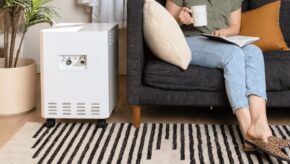The air inside of your home is heavy with a thick layer of pollution that has not only tainted the smell of the air in your indoor space, but it has also started to impact your health and the health of the other occupants in this space. There are many various airborne substances that can find their way into your indoor space, whether that be from different household items that emit these substances into the air or from outside sources in the environment that find their way lingering into the indoor air of your home. Either way, the gaseous substances will invade the air space and potentially leave the environment contaminated.
Among the different substances and gases that can find their way inside of a home, ozone is a pollutant that may become a problem inside of your home’s air. Ozone is a gas that can come from both the outdoor environment from the upper atmosphere, as well as from different appliances in this indoor space such as vacuum cleaners, refrigerators, and even air purifiers placed in this space. What can you do when ozone emissions in your home reach an uncomfortable or unsafe level and what are the potential effects from ozone gas exposure?
In this article learn more about the possible dangers of ozone emissions in a home, the different sources that can be producing ozone, and the best way on how to remove ozone from your home.
What is Ozone Gas
Ozone gas is a substance that can have a significant impact on the indoor air space of an environment, due to its potentially volatile nature. Ozone, also known as O3, is a highly reactive gas that is composed of three oxygen atoms – in comparison to the two oxygen atoms of breathable oxygen found in the environment. This gas, as we discussed previously, is both a natural and man-made product that occurs in the Earth’s upper atmosphere and lower atmosphere. Ground-level ozone is the type of ozone that is primarily found within a home and is a form of ozone that is constructed primarily from a photochemical reaction between two major classes of air pollutants found in the air, volatile organic compounds (VOCs) and nitrogen oxides (NOx), according to the EPA.
Typically, when we think about ozone gas, we tend to think of it as an outdoor pollutant, as it is known for being one of the main components of smog in the air. However, this outdoor pollutant will also have the potential to infiltrate the indoor environment of a home or other indoor space. Some ozone emissions inside of a home will likely come from sources such as copy machines, laser printers, ultraviolet light, and some air purification technologies that will emit this airborne gas into the environment.
How Does Ozone Work
Another form of oxygen, ozone possesses an unstable third oxygen atom that works to detonate to oxidize organic materials found in the air and in the water. This chemical has 3,000 times the effectiveness of bleach, and can also kill other contaminants such as bacteria, viruses, and odors. When these gaseous compounds are emitted into the air it will release its unstable third oxygen atom into the air space in an attempt to attach to other pollutants floating in the air. The ozone atoms will float throughout the air and form to contaminants they stumble across in the air, leaving only oxygen molecules left behind in the air space.
The lifespan of ozone, however, is fairly short in the indoor air as the ozone will form within the environment and either they will disperse in the room or revert back into oxygen. Additionally, ozone itself has a half-life which means that “residual” ozone will return to oxygen usually within 30 minutes. Although this will occur within a short time frame, there are still some risks of inhalation of ozone (O3) molecules which can be potentially dangerous to human health.
Does Ozone Smell
Are you familiar with the smell that follows after it rains? An odor that smells “clean” but triggers you to associate it with the aroma of rain after it falls from the sky. This “clean” smell is an odor that is produced from none other than ozone molecules that are released during a rainstorm. Before a storm takes place outside your home’s door, when lighting occurs in the sky it can sometimes rip nitrogen and oxygen molecules in the environment into pieces that will ultimately result in the emission of ozone in the air. When ozone gets caught in the wind it will be carried down to ground level and potentially impact the smell inside of a home.
Overall, the smell of ozone will be a very recognizable odor and something that will easily be detected inside of a home. However, what does ozone smell like and is this odor a potential risk to human health when smelt in the environment?
What Does Ozone Smell Like
Although the smell of ozone may be disguised in a pleasant clean smelling aroma, the ozone odor is anything but safe, especially in higher concentrations in the air. Did you know that the average human nose can pick out the distinctive smell of ozone at concentrations as low as 10 PPB (parts per billion)? Ozone smell in house and its compounds is a strong aroma that can be dangerous and have a potentially lasting effect of the human body, particularly the lungs. The problem with this scent is that it can be caused from uncontrollable events such as rainstorms that will unsuspectingly produce this gas into the air. Other than the smell of “clean” that comes from a rainstorm, ozone has also been compared to other odors such as metallic, burning wire, and even chlorine. Therefore, it is important to keep a helpful nose out for any of these scents in the indoor air of your home.
Is Ozone Bad for You?
The exposure to ozone in your personal indoor air space is something that can lead to potentially dangerous health effects, depending on the level of exposure, length of exposure, and the conditions in the indoor environment (like airflow and ventilation). According to the American Lung Association, ozone is a potent lung irritant and any form of exposure to elevated levels of ozone in the air will be a major contributor to the exacerbation of lung diseases. Ozone exposure can be especially harmful to certain individuals such as those people suffering from asthma or other chronic lung diseases, children, and the elderly.
The EPA released a research report on ozone pollution in February of 2013 that examined ozone pollution and its contribution to serious threats to health. To learn more about the impact of ozone on human health, read the EPA’s ozone research now.
Sources of Ozone in Home
It may come as a surprise to learn that there are a variety of products that can be found inside of a home that will lead to ozone pollution in this air space. Among the most prominent sources of ozone emission inside of an indoor environment will include laundry water treatment appliances, facial steamers, and even air purifiers that are used within this confined space. However, air purifiers are the most likely culprit for ozone emissions in your home, which is crazy to think about because homeowners willingly place these machines in their home to try to mitigate indoor pollutants and odors from the air space.
In an effort to control and mitigate airborne pollutants found in a home ozone producing air purifiers will be placed in these environments to restore the indoor air quality. Although, ultimately these air purifiers will be potentially one of the sole sources of ozone production in a home, and this can lead to ozone smell in the air, adverse health effects from ozone exposure, and even risks to your overall IAQ.
Ozone Filtration vs Alternative Home Air Filters
There are many different types of air filtration technologies that are used in home’s today, anything from carbon filters, ozone, air ionizers, and even HEPA filters that will help to mitigate and filter the indoor air of a home. All of these different filters will work through specific technologies that will give the air filters its capability to remove certain airborne pollutants from the air, such as chemicals, odors, and/or particulate matter. The problem with many of these air filtration technologies, however, is that contrary to what it is supposed to be doing for the air quality it can actually be producing ozone byproducts into the air that can be potentially dangerous when present in an occupied indoor space.
Ozone Generators & Ionization Filtration
Ozone filtration is usually found in ozone generators and ionization purifiers that will release this chemical byproduct into the air as a means to removing pollutants. These devices work by emitting ozone molecules into the air that are said to help remove a variety of airborne particles such as particulate matter, chemicals, mold, viruses, bacteria, and odors. However, the emission of ozone into the air will lead to certain health risks, as occupants can sometimes be exposed to these O3 molecules in the air and inhale them, which will cause potentially adverse health effects. Similarly, ionization filtration that is used in many air purifiers will also emit ozone byproducts into the air. Although when it comes to the level of ozone production created by both ionic air filtration and ozone machines, the amount emitted from ionic filters will pale in comparison to the levels created by ozone machines.
HEPA Filters
Another popular form of air filtration that is used in a variety of air purification devices and central air handling systems within a home is a HEPA filter. A HEPA filter, unlike ozone and ionization filtration, does not release any chemical byproducts into the air such as ozone. Rather the HEPA filter works by having a thick media filter that is made of very fine glass threads that are tangled together and compressed to form the filter material of the HEPA. These individual threads on the HEPA filter media will allow this filter to trap and capture many airborne pollutants, including fine particulate matter that is as small as 0.3 microns in size. These filters generally have a life of about 2 to 3 years, which makes them a superior option in air filtration, as well as their capability to remove pollutants without the use of hazardous chemical emissions in the air.
How to Remove Ozone from Air of Your Home
If you have recently ran an ozone machine or ionization air purifier inside of your home, then your home may be at risk of having elevated levels than can be potentially dangerous to both the indoor air quality and human health in this environment. What can you do when your home has become inundated with a harmful gaseous compound like ozone molecules in the air? The best thing an individual can do that is dealing with elevated levels of ozone in their home, is to increase air flow and ventilation, along with adding safe air quality solutions that will help to eradicate these potentially harmful ozone compounds in the air. As we discussed previously, one of the most effective and safest air filtration technologies used today is a HEPA filter, which focuses on particulate removal in the air. However, when it comes to the removal of noxious and toxic chemicals and odors present in the air, you will have to find an air quality solution that is safely able to accomplish this chemical and odor removal, while still integrated HEPA filtration in the environment.
The EnviroKlenz Air Purifier is a revolutionary air purification device that utilizes a two-filtration process that includes a proprietary earth mineral technology for odor and chemical neutralization, as well as a hospital-grade HEPA filter for fine particulate removal in the air. The EnviroKlenz patented earth mineral technology works by capturing, containing, and neutralizing/breaking down noxious and toxic chemicals and odors from the air, all without using chemicals or producing byproducts into the airspace of this indoor environment. In addition to this proprietary EnviroKlenz technology, this air purifier also contains a second stage filtration that uses a hospital-grade HEPA filter for fine particulate removal larger than 0.3 microns in size at a 99.99 percent efficiency.
Article Sources:








